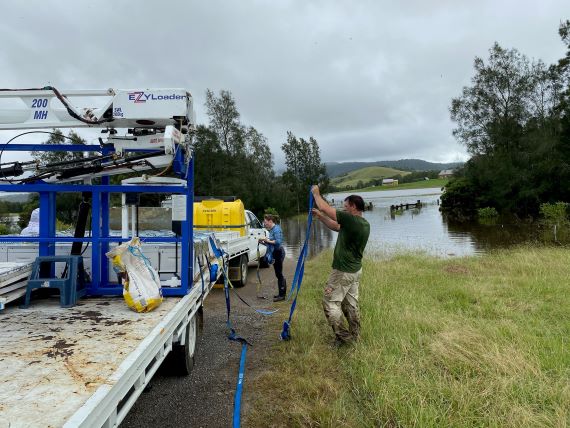
Floods and beekeeping

Flooding affects all livestock, including honey bees. Where floodwaters have passed through bee hives, once the beekeeper can safely access the apiary, there are immediate tasks to undertake. Any hives that were submerged are potentially damaged and contaminated. Any brood (juvenile bees) that went under water are likely to have perished.
Swift action should be taken for flood-affected hives to have any chance of recovery:
1. If floodwaters were muddy or polluted, comb/frames should be culled and burnt. Your frames (where the bees store honey in beeswax comb) are a food-producing material, will now be contaminated and no longer “food safe.” Additionally, it’s a big ask for your bees to rehabilitate contaminated material. Hives may become a target for the pest small hive beetle, potentially creating even bigger biosecurity problems.
2. If floodwaters were clean and uncontaminated, prevent small hive beetle infestation by removing frames of dead brood and installing small hive beetle traps or harbourages. If small hive beetle larvae are already present, cull affected frames or potentially entire hives depending on the severity of the infestation and hive strength.
3. Assess your hive’s likelihood of recovery and the cost involved:
- Does the adult bee population justify the labour and inputs (i.e. new comb, supplemental feed, new queen) necessary to recover it to full strength and productivity?
- Is a laying queen present?
- Is it disease free?
If the answer to the above questions is “no” tough decisions need to be made on the future of the affected hive. If the adult population is too small to justify the labour and inputs to bring it back up to production strength, and it is disease and pest free, it could be combined with another hive. If the hive also has disease or pests present, it may be necessary to cull the entire hive. If the hive population is low, without a queen, and you have no access to mated queen bees, combining the remaining bees and salvageable comb with a stronger, disease-free hive may be the best option.
4. Where recovery is possible, supplemental feed with sugar syrup (2 parts sugar to 1 part water in autumn - winter) and possibly a protein supplement. Monitor for small hive beetle activity. Remember, building new comb is only possible when your bees are on a nectar flow or receiving supplemental feed over and above their immediate needs for survival.
Information on supplemental feeding can be accessed from the Nutrition tab in the Managing your hives web page.
Assistance
If you require emergency assistance to care for your hives as a result of floods, call the Agriculture and Animal Services Hotline on 1800 814 647. Once your request is registered, staff will call you back to discuss your individual circumstances and help identify available assistance.
Visit Disaster and grant funding on the Service NSW page.

